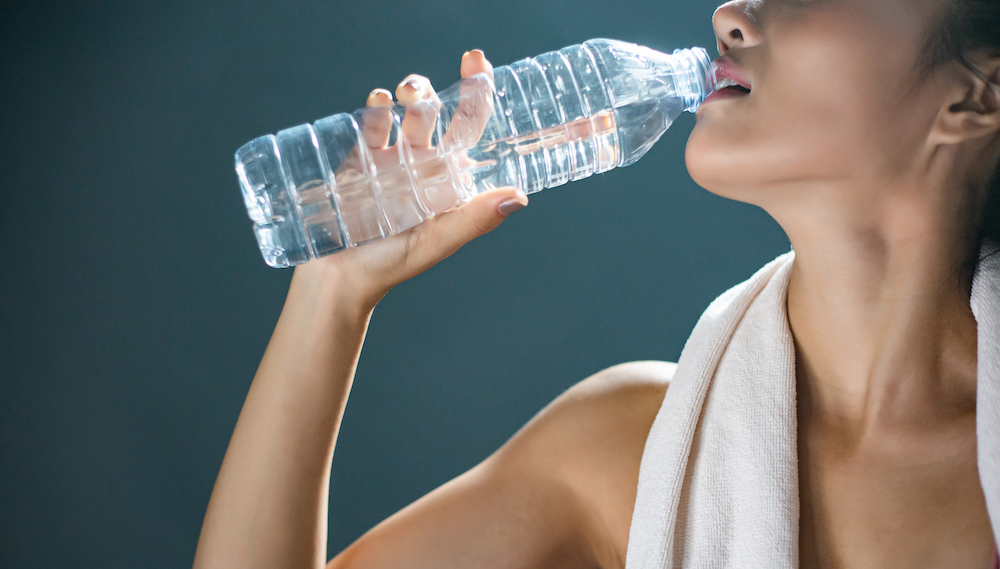Hydration is important, so let’s break down the most common challenges and find solutions. According to Dietitians Australia, dehydration can affect “heart rate, body temperature, dizziness, fatigue, constipation, poor skin and muscle cramping” (1). According to leading American sports dietitian Dan Benardot PhD, RD, “As little as a two percent drop in body water results in a measurable reduction in athletic performance” (2).
Problem: Knowing your fluid needs
Solution: The individual amount needed depends on inside and outside temperature, a dancer’s size, how much they are sweating, and foods they ate that contain fluids. Foods and beverages contain electrolytes like sodium and potassium and thus affect fluid retention and output. The longer a dancer is exercising, the more fluids they need. A typical class is 90 minutes, so a dancer should drink fluids (240-500 ml) before class, during the break before center (240-500 ml) and hydrate well after class and throughout the day (500+ml at a time). On average, 2000-2500 ml/day would be a baseline amount.
Plan ahead! If you start dancing underhydrated, it’s almost impossible to catch up while exercise is happening. Hydrate ahead of time, and continue to sip every 15-30 minutes during exercise. Your water bottle needs to be your constant companion. If your urine color is dark yellow, you’re probably dehydrated. However, excess vitamin supplements can darken the color of urine.
Problem: Uncomfortable gastrointestinal problems
Solution: Knowing how sugars in beverages can affect the gut. Ever feel bloated or nauseous after drinking certain things? Don’t let this fear keep you from hydrating. Know your body and that it can adapt. Dietary sugars are absorbed differently and can affect the gastrointestinal system in individual ways.
Fruit and fruit juice which contain fructose are classic health foods with many benefits including being hydrating. During heavy exercise, large amounts at one time could lead to stomach upset or bloating in some people because of the timing in which it empties from the stomach and gets absorbed in the GI tract. Don’t just eliminate fruit and fruit juice entirely! Try drinking 240ml at a time, and remember that bodies adapt with training. Fruits contain vitamins A, C, along with minerals like potassium that prevents muscle cramping, and antioxidants reduce muscle soreness. The natural sugars are also a good source of energy for working muscles and brain. Fructose is not a bad thing, but it can be helpful to know that volume consumed, timing and how hard the dancer is working can affect people differently.
Sports beverages have a carefully researched mix of sucrose plus glucose (and occasionally high-fructose corn syrup) which are designed to be easily absorbed and used as energy with fewer GI side effects. Each product is slightly different. These are best saved for longer duration exercise or for exercising outside on a hot day or under hot stage lights. They’re not usually necessary for short-term exercise like just one class or one rehearsal indoors. Water is usually sufficient for short-term needs.
Cow’s milk/dairy products contain the naturally occurring sugar lactose which requires the enzyme lactase to digest it. Humans produce less and less lactase as they grow up, so it’s common for older teens and adults to have bloating, gas or constipation after drinking cow’s milk. Dairy is a good source of calcium, vitamin D and protein, but other dietary sources also have these. Soy milk, almond milk and non-dairy protein smoothies can be hydrating and contain key vitamins and minerals. Protein is certainly important but can be found in many other sources if cow’s milk bothers your stomach. There is a pill form of lactase available if necessary.
Problem: Caffeine from beverages affects everyone differently.
Solution: Caffeine isn’t as dehydrating as we once thought; however, people tolerate caffeine differently and the body adapts to the amount over time. Some get jittery and nervous, but others focus better with caffeine. Know how much caffeine is in your favorite beverages. It’s considered an ergogenic aid by sports dietitians because it does increase alertness, reduce fatigue and aid in performance…up to a point. 250ml black tea has 40-60mg, brewed coffee has 100-150mg, Cola drinks 35-50mg (2). However, so called “energy drinks” can have up to three times the amount of caffeine as a cup of coffee and are usually high in sugar and food dyes. Caffeine suppresses appetite which could lead to inadequate energy intake. Caffeine just stimulates the central nervous system; the only real “energy” that fuels the brain and working muscles comes from food. Don’t let caffeinated drinks become a substitute for real food.
Find what work for you. Kombucha, herbal teas and protein drinks can be good. Even sparkling water can be just as hydrating as regular still water if the carbonation doesn’t bother you.

By Emily C. Harrison MS, RDN, LDN of Nutrition for Great Performances.
Emily Cook Harrison MS, RD, LD
Emily is a registered dietitian and holds both a bachelor’s and master’s degree in nutrition from Georgia State University, USA. Her master’s thesis research was on elite level ballet dancers and nutrition and she has experience providing nutrition services for weight management, sports nutrition, disordered eating, disease prevention, and food allergies. Emily was a professional dancer for eleven years with the Atlanta Ballet and several other companies. She is a dance educator and the mother of two young children. She now runs the Centre for Dance Nutrition and Healthy Lifestyles. She can be reached at emily@dancernutrition.com
www.dancernutrition.com
Sources:
- Dietitians Australia: Fluids and Health. member.dietitiansaustralia.org.au/Common/Uploaded%20files/DAA/Resource_Library/2021/Fluids_and_health.pdf
- Benardot D. Advanced Sports Nutrition: fine-tune your food and fluid intake for optimal training and performance third ed. Human Kinetics 2021

















